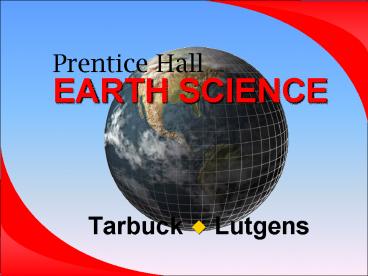Prentice Hall EARTH SCIENCE - PowerPoint PPT Presentation
1 / 36
Title:
Prentice Hall EARTH SCIENCE
Description:
3.1 The Rock Cycle. Rocks are any solid mass of mineral or ... Fossiliferous Limestone. Classification of. Sedimentary Rocks. Features of Some Sedimentary Rocks ... – PowerPoint PPT presentation
Number of Views:1923
Avg rating:3.0/5.0
Title: Prentice Hall EARTH SCIENCE
1
Prentice Hall EARTH SCIENCE
- Tarbuck Lutgens
?
2
Chapter 3
Rocks
3
3.1 The Rock Cycle
? Rocks are any solid mass of mineral or
mineral-like matter occurring naturally as part
of our planet.
? Types of Rocks
1. Igneous rock is formed by the crystallization
of molten magma.
4
3.1 The Rock Cycle
? Types of Rocks
2. Sedimentary rock is formed from the weathered
products of preexisting rocks that have been
transported, deposited, compacted, and cemented.
3. Metamorphic rock is formed by the alteration
of pre-existing rock deep within Earth (but still
in the solid state) by heat, pressure, and/or
chemically active fluids.
5
3.1 The Rock Cycle
? Shows the interrelationships among the three
rock types (igneous, sedimentary, and metamorphic)
? Magma is molten material that forms deep
beneath the Earths surface.
? Lava is magma that reaches the surface.
? Weathering is a process in which rocks are
broken down by water, air, and living things.
? Sediment is weathered pieces of Earth elements.
6
The Rock Cycle
7
3.1 The Rock Cycle
? Processes driven by heat from the Earths
interior are responsible for forming both igneous
rock and metamorphic rock.
? Weathering and the movement of weathered
materials are external processes powered by
energy from the sun.
? External processes produce sedimentary rocks.
8
3.2 Igneous Rocks
1. Intrusive igneous rocks are formed when magma
hardens beneath Earths surface.
2. Extrusive igneous rocks are formed when lava
hardens.
9
3.2 Igneous Rocks
? Igneous rocks can be classified based on their
composition and texture.
1. Texture
Coarse-grained texture is caused by slow
cooling resulting in larger crystals.
Fine-grained texture is caused by rapid
cooling resulting in smaller, interconnected
mineral grains.
10
Course-Grained Igneous Texture
11
Fine-Grained Igneous Texture
12
3.2 Igneous Rocks
1. Texture (continued)
Glassy texture is caused by very rapid
cooling.
Porphyritic texture is caused by different
rates of cooling resulting in varied sized
minerals.
2. Composition
Granitic composition rocks are made mostly of
light-colored quartz and feldspar.
13
Obsidian Exhibits a Glassy Texture.
14
Porphyritic Igneous Texture
15
3.2 Igneous Rocks
2. Composition (continued)
Basaltic composition rocks are made mostly of
dark-colored silicate minerals and plagioclase
feldspar.
Andesitic composition rocks are between
granitic light-color minerals and basaltic
composition dark-colored minerals.
Ultramafic composition rocks are made mostly
from iron and magnesium-rich minerals.
16
Basalt
17
Classification of Igneous Rocks
18
3.3 Sedimentary Rocks
? Weathering, Erosion, and Deposition
Erosion involves the weathering and the
removal of rock.
Deposition occurs when an agent of
erosionwater, wind, ice, or gravityloses energy
and drops sediments.
19
3.3 Sedimentary Rocks
? Compaction and Cementation
Compaction is a process that squeezes, or
compacts, sediments.
Cementation takes place when dissolved
minerals are deposited in the tiny spaces among
the sediments.
20
3.3 Sedimentary Rocks
? Two Main Groups
1. Clastic sedimentary rocks are composed of
weathered bits of rocks and minerals.
Classified by particle size
Common rocks include
- Shale (most abundant)
- Sandstone
- Conglomerate
21
Shale with Plant Fossils
22
Conglomerate
23
3.3 Sedimentary Rocks
? Two Main Groups
2. Chemical sedimentary rocks form when dissolved
substances precipitate, or separate, from water.
- Common rocks include
- limestonemost abundant chemical rock
- microcrystalline quartz known as chert, flint,
jasper, or agate
- evaporites such as rock salt or gypsum
- coal
24
Fossiliferous Limestone
25
Classification of Sedimentary Rocks
26
3.3 Sedimentary Rocks
? Features of sedimentary rocks are clues to how
and where the rocks are formed
27
3.4 Metamorphic Rocks
? Metamorphism means to change form.
? Most metamorphic changes occur at elevated
temperatures and pressures.
? Conditions for formation are found a few
kilometers below the Earths surface and extend
into the upper mantle.
28
3.4 Metamorphic Rocks
? Contact metamorphism occurs when magma moves
into rock.
- Occurs near a body of magma
- Changes are driven by a rise in temperature.
29
3.4 Metamorphic Rocks
? Regional metamorphism results in large-scale
deformation and high-grade metamorphism.
- Directed pressures and high temperatures occur
during mountain building.
- Produces the greatest volume of metamorphic rock
30
3.4 Metamorphic Rocks
? Heat
- Provides the energy needed to drive chemical
reactions
? Pressure
- Causes a more compact rock with greater density
31
Origin of Pressure in Metamorphism
32
3.4 Metamorphic Rocks
? Hydrothermal Solutions
- Hot water-based solutions escaping from the mass
of magma
- Promote recrystallization by dissolving original
minerals and then depositing new ones
33
3.4 Metamorphic Rocks
? Two main categories
1. Foliated Metamorphic Rock
- Has a banded or layered appearance
2. Nonfoliated Metamorphic Rock
- Does not have a banded texture
34
Classification of Metamorphic Rocks
35
Gneiss Typically Displays a Banded Appearance
36
MarbleA Nonfoliated Metamorphic Rock































